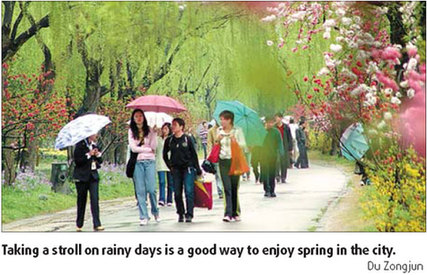
Yangzhou cuisine is representative of the culinary cultures of the Yangtze and Huaihe river region. Local delicacies include "lion's head" meatball stew (hong shao shi zi tou), boiled sliced tofu (da zhu gan si) and stir-fried shrimp (chao xia ren). Yangzhou dumplings (baozi) and Yangzhou fried rice (Yangzhou chao fan) have also gained global popularity comparable to sweet and sour pork.
The city's other favorite pastime involves going to public bathhouses. It's nothing like the morning shower you're used to - in Yangzhou, personal hygiene is a social event for friends and relatives to catch up.
Common bathhouse activities also include massages, manicure and pedicure. In fact, one of Yangzhou's famous "three knives" is a kind of carving knife used by a pedicurist to cut out corns on the feet. The other two are the kitchen knife and scissors.
While shopping centers and karaoke bars occupy much of the new city, the old town section of Yangzhou is characterized by old-fashioned courtyards and cobblestone alleys.
Some of the alleyways are so narrow that only one person can pass through it at a time. If you're a good rider you can ride a bike through it as well. But if there's another bike coming from the opposite direction, one of you will have to concede and back up.
It doesn't take long for the intimate charms of the city to grow on you. Like Beijing, Yangzhou has thousands of years of history as a cultural center. But while Beijing expanded to impossible proportions, Yangzhou kept a modest population and the town is small enough to know your way around after a couple of days.
The Jinghang (Bejing-Hangzhou) Grand Canal that runs through the city is a good landmark to follow. The ancient waterway was first constructed in 486 BC, and it stretches 1,800 km from Zhejiang province's Hangzhou city all the way north to Beijing.
Yangzhou is a city with history. Italian traveler Marco Polo served in Yangzhou as an official from 1281 to 1287. Many classic poets have also paid tribute to the beautiful city in their verses that remain popular today.
During the Qing Dynasty, a group of painters in Yangzhou sought breakthroughs in their art. For their radical rejection of traditions and innovative spirit, they were named the "eight eccentrics" and are commemorated by locals till this day.
But instead of being burdened by the past, Yangzhou people find ways to keep it alive.
Traditional Chinese art such as calligraphy, brush painting and guzheng (an ancient plucked instrument) thrive in this city. Usually regarded as hobbies of retirees in Beijing, these traditional art forms are taken seriously here by both the young and old.
Even though I have been away for so many years, I still feel part of the tight-knit community that is deeply aware of its historic roots. I am proud of this beautiful city and feel fortunate to call it home.
(China Daily March 10, 2008)